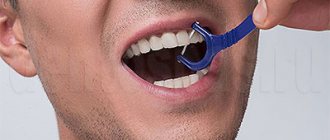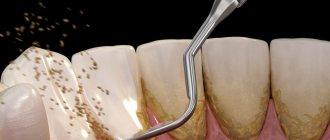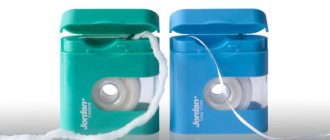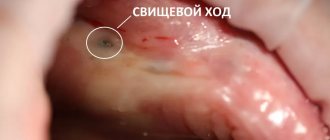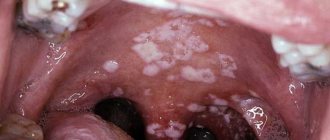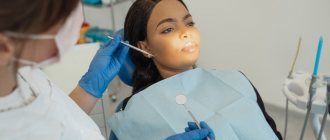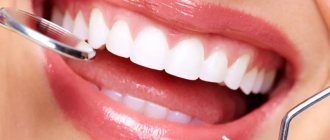Causes of enamel hyperesthesia
Many patients complain of increased sensitivity of teeth after tartar removal. The main reason for such complaints is the exposure of hard tooth tissues that were previously covered with tartar. The deposits partially reduced the impact of irritants - high and low temperatures, sour, sweet and spicy foods. Therefore, after the stone is removed, the enamel reacts more sharply to external factors.
Increased tooth sensitivity is caused by:
- existing diseases of the oral cavity - caries, pulpitis,
- thinning of tooth enamel in the cervical area,
- non-compliance with professional cleaning rules.
To reduce the likelihood of enamel hyperesthesia, have your teeth cleaned only by qualified dentists. Contact only experienced specialists in whose professionalism you are confident.
What it is
Tartar is a hardened plaque that forms in adults and very rarely in children, and even then in the presence of a history of serious diseases such as heart disease or diabetes. Usually, if you spend enough time on hygienic procedures to remove plaque, stones will not form on your teeth. If plaque is not allowed to harden, stones cannot form. Therefore, thorough brushing of teeth is the best means of prevention.
Tartar can occur on one single tooth or on several teeth. The lower front teeth, as well as the upper and lower molars, are most susceptible to tartar formation.
Signs:
- Tartar causes bad breath;
- gums begin to itch and bleed;
- Dark stains appear on the visible surfaces of the teeth that cannot be removed with a brush.
Tartar can form not only on enamel, but also on crowns or dentures. Therefore, those who do not have their own teeth in their mouth, but only dentures, should not relax - stone can form on them, just like on the surface of the enamel. It, of course, will not lead to caries on the crown, but it can provoke inflammation of the gums, and also significantly spoil the appearance of the dentures.
Plaque from tea and cigarettes can provoke the formation of tartar. The constant presence of such plaque on hard-to-reach enamel surfaces inevitably leads over time to the formation of dense deposits, including stones.
Complex of symptoms
Increased sensitivity of teeth after cleaning from tartar can manifest itself in different ways. Most often, patients feel:
- discomfort when chewing food and brushing teeth,
- aching pain of varying degrees of intensity when leaving a warm room into the cold, eating hot and cold foods and drinks.
Normally, this condition can persist for 2-7 days. If enamel hyperesthesia does not go away or worsens over time, do not delay your visit to the dentist.
Increased tooth sensitivity after professional cleaning
After professional teeth cleaning, especially after cleaning the subgingival area, teeth may become overly sensitive for a while. Gradually this feeling will disappear and your teeth and gums will be healthier than before. If the increased sensitivity of teeth that occurs after professional oral hygiene persists longer than usual, the dentist will provide you with the necessary assistance and give recommendations.
Professional teeth cleaning
The only way to get rid of calcified plaque, that is, tartar, is to have your teeth professionally cleaned at your dentist's office. Tartar most often forms on the surface of teeth along the gum line or below the gum line, as well as in other areas that are difficult to reach with a toothbrush. The dentist or hygienist removes it using special instruments, scalers. This procedure is called scaling. The hygienist can also perform root smoothing - remove plaque and tartar from the top of the tooth roots by inserting an instrument between the tooth and the gum.
Before such treatment, the gums may be inflamed and swollen. Sometimes deep gaps, so-called periodontal pockets, even form between the gum and tooth, in which bacteria accumulate. Removing dental plaque and smoothing the root surface allows you to get rid of these problems, but the procedure itself can cause discomfort and bleeding gums. If the dentist has reason to believe that the cleaning process will be particularly unpleasant for the patient, he may use local anesthesia.
What happens next
General soreness, increased tooth sensitivity and bleeding gums are normal reactions of oral tissues to professional teeth cleaning. Some of these reactions are caused by the contact of instruments with inflamed gums that easily begin to bleed. Other reactions are due to the fact that as a result of this procedure, those areas of the teeth that were previously covered with plaque or tartar are exposed. Where gum recession occurs, scaling exposes the neck or root of the tooth, and it takes time for the teeth to adapt to the new condition. Since the neck and root are not protected by strong enamel, they are more sensitive than the crown of the tooth.
Sensitive teeth
Dentists believe that normally, bleeding, discomfort and increased sensitivity of teeth after professional oral hygiene can last no longer than a week. With careful and regular oral hygiene, swelling, hypersensitivity and bleeding of the gums gradually decrease, but the feeling of general discomfort in most patients disappears in one or two days. As for increased tooth sensitivity, in everyday life - especially when drinking hot drinks and cold food, chewing food and brushing teeth - it is quite difficult to avoid unpleasant sensations, but after a week they should stop bothering you.
Caring for your teeth after professional cleaning
Careful dental care following professional oral hygiene helps gums heal by reducing exposure to irritants that cause pain and sensitivity. Stop flossing for at least a day; While your gums are still sore, gently brush your teeth using a soft-bristled brush and a special toothpaste for sensitive teeth. Avoid foods and drinks that cause discomfort. If tooth sensitivity persists for more than a week after professional cleaning, or if other problems arise, make a follow-up appointment with your dentist, who will check how well your gums are healing and possibly apply a special professional solution to sensitive areas of your teeth.
Teeth hypersensitivity after professional cleaning is not a problem that requires immediate medical intervention: you can cope with it yourself by using a special toothpaste and watching your diet. If symptoms persist for more than a week, contact your dentist, but remember that discomfort may also be caused by mistakes you made during oral care.
Treatment and prevention measures
To reduce the risk of developing hyperesthesia, fluoridation is carried out after professional hygiene with the removal of tartar. Procedure:
- saturates the enamel with useful substances that help strengthen it and restore its structure,
- reduces the likelihood of developing caries.
To avoid enamel hypersensitivity after removing tartar, you must follow the following rules:
- do not eat or drink for two hours after the procedure,
- give up solid and rough foods for a day,
- use a toothbrush with soft bristles,
- Use mouth rinses regularly.
To maintain healthy teeth and gums, professional hygiene with the removal of soft bacterial plaque and tartar should be carried out twice a year.
Kinds
There are two types of tartar, depending on its location - subgingival and supragingival.
Subgingival tartar can only be detected by a dentist using a special probe, since it is hidden from view by the edge of the gum. It is located in the periodontal pocket and fits tightly to the root. The color of this stone is usually dark brown or greenish-black, it is extremely hard and consists mainly of calcium phosphate, magnesium phosphate and calcium carbonate. If subgingival stone is not removed in a timely manner, it can provoke an inflammatory process in the periodontium and cause periodontitis.
Supragingival tartar can be diagnosed independently; it stands out on the surface of the enamel with its yellowish or brownish color and is easily removed using a dental excavator. It is usually located above the crest of the gingival margin, so it is easy to recognize. In terms of density, supragingival stone is much softer than subgingival stone, since it is a salivary type formation and consists mainly of epithelial cells, bacteria, mucus and food debris. If it is not removed in a timely manner, over time the hardened plaque turns into caries.
How is tartar formed?
Stone formation begins when plaque remains on the teeth after eating. At first soft and friable, in the absence of proper oral hygiene, it gradually reacts with the components of saliva, oxidizes and hardens. Over time, layers of plaque mineralize and tartar forms.
Plaque, which eventually turns into tartar, comes in two types:
- Subgingival
Plaque that can form on any tooth, regardless of its location. You won’t be able to detect it yourself; this can only be done by a doctor using a probe or gum recession.
- Supragingival
This plaque usually forms on the teeth closest to the salivary glands and has a yellowish or gray-brown tint. You can detect it in the oral cavity yourself, but it can only be removed with the help of a dentist.
Folk remedies for relieving gum pain
Simple folk recipes will also help relieve gum inflammation and soothe the tissues:
- Prepare a decoction of sage and chamomile by taking a tablespoon of the raw material and pouring a glass of boiling water over it. The herbs must be infused in a steam bath for 15-20 minutes, and then rinsed throughout the day. As a rule, the pain noticeably subsides after the third rinse.
- A solution of baking soda can quickly eliminate gum inflammation after professional teeth cleaning. It is enough to dissolve a teaspoon of baking soda in a glass of water and rinse your mouth with the mixture several times a day.
For acute inflammation of the gums, dentists advise using the unique ASEPTA gel with propolis. The product with the waste product of bees provides action in four directions: antimicrobial, anti-inflammatory, healing and analgesic.
We hope that gum inflammation after brushing your teeth will not torment you, and this hygiene procedure will become your usual care and a way to maintain a healthy, snow-white smile.
Sources:
- Report on clinical trials to determine/confirm the preventive properties of commercially produced personal oral hygiene products: mouth rinse "ASEPTA PARODONTAL" - Solution for irrigator." Doctor of Medical Sciences Professor, Honored Doctor of the Russian Federation, Head. Department of Preventive Dentistry S.B. Ulitovsky, doctor-researcher A.A. Leontiev First St. Petersburg State Medical University named after academician I.P. Pavlova, Department of Preventive Dentistry.
- Report on clinical trials of anti-inflammatory balm for gums "Asepta" adhesive, St. Petersburg State Medical University, 2007
- The role of anti-inflammatory rinse in the treatment of periodontal diseases (L.Yu. Orekhova, A.A. Leontyev, S.B. Ulitovsky) L.Yu. OREKHOVA, Doctor of Medical Sciences, Prof., Head of Department; A.A. LEONTIEV, dentist; S.B. ULITOVSKY, Doctor of Medical Sciences, Prof. Department of Therapeutic Dentistry of St. Petersburg State Medical University named after. acad. I. P. Pavlova
What is Air Flow
The Air-Flow method can be classified as a mechanical method of brushing teeth. This cleaning is very simple: a water-abrasive solution is supplied into the oral cavity under pressure, which “breaks” and removes hardened plaque in places that are inaccessible to other methods (between the teeth and on the gums). Using the same method, the dentist carefully polishes the enamel, which allows it to be lightened by several tones. For extensive tartar damage to teeth, this method is used as a complement to laser or ultrasonic cleaning.
Is ultrasonic teeth cleaning harmful?
Ultrasonic cleaning does not pose any threat to teeth and the body as a whole. An exception is situations in which the technology is broken or the patient has contraindications. Ultrasound can damage enamel if it is thinned or has such a structural feature. Sometimes brushing causes bleeding from the gums. The doctor will help stop it and advise what needs to be done for speedy healing.
Advice: to avoid possible troubles, before starting the procedure, the dentist finds out the state of health, concomitant diseases, and reaction to medications. Answer honestly and directly, every nuance matters.
What does tartar look like?
Tartar is a mineralized, dark-colored plaque on teeth. It is deposited mainly on the back side of the front teeth and in hard-to-reach interdental spaces; it consists of dead cells, bacteria and salts.
There is a misconception that tartar itself is not noticeable and not scary, and its presence does not in any way affect the health of the teeth. This misconception makes people not notice the growing plaque for years until the gums become inflamed in the affected area or a carious cavity forms. It is important to understand that tartar poses a serious danger to human health; it must be diagnosed promptly and disposed of immediately.
Causes
If you have stones, the reason for their occurrence may be the following:
- lack of systematic oral hygiene;
- use of low-quality accessories for brushing teeth;
- the presence of a large amount of dental plaque;
- violation of salt metabolism;
- increased viscosity of saliva, as a result of which it loses its cleansing properties and does not wash away plaque;
- insufficient consumption of solid foods, which promote self-cleaning;
- unilateral chewing of food (only on the left or only on the right side of the jaw) as a result of the presence of diseased or missing teeth in the patient’s mouth;
- increased roughness of the enamel surface as a result of filling or orthodontic treatment;
- smoking.
Mechanical stone removal
Mechanical method
Initially, tartar was removed only mechanically - using a special metal hook, which was used to separate the stone from the tooth. The procedure was quite painful and traumatic, so in recent years this method has not been popular; it has been replaced by more effective and much less traumatic ones.
Ultrasound removal
Ultrasound removal
Ultrasound technology has become widespread in modern dentistry, through which tartar removal is carried out as efficiently and painlessly as possible. The technology does not involve contact of the device with the surface of the tooth; enamel cleansing occurs due to directed ultrasonic waves of a certain frequency. The procedure is painless, however, if there is high sensitivity or at the request of the patient, the doctor can use an anesthetic gel.
Despite the popularity of the ultrasound method, it also has some disadvantages:
- an inexperienced dentist can make a number of mistakes that can lead to damage to the gums and enamel;
- increased sensitivity and severe demineralization of teeth can cause pain during and after the procedure;
- the ultrasonic method cannot always be used to remove subgingival stone;
- The ultrasound method is not suitable for patients with a large number of old fillings due to the risk of them falling out.
There are also restrictions on the use of ultrasound for patients with cardiovascular diseases and installed pacemakers. Before the procedure, the doctor will definitely ask the patient about possible contraindications and, if necessary, recommend another method.

